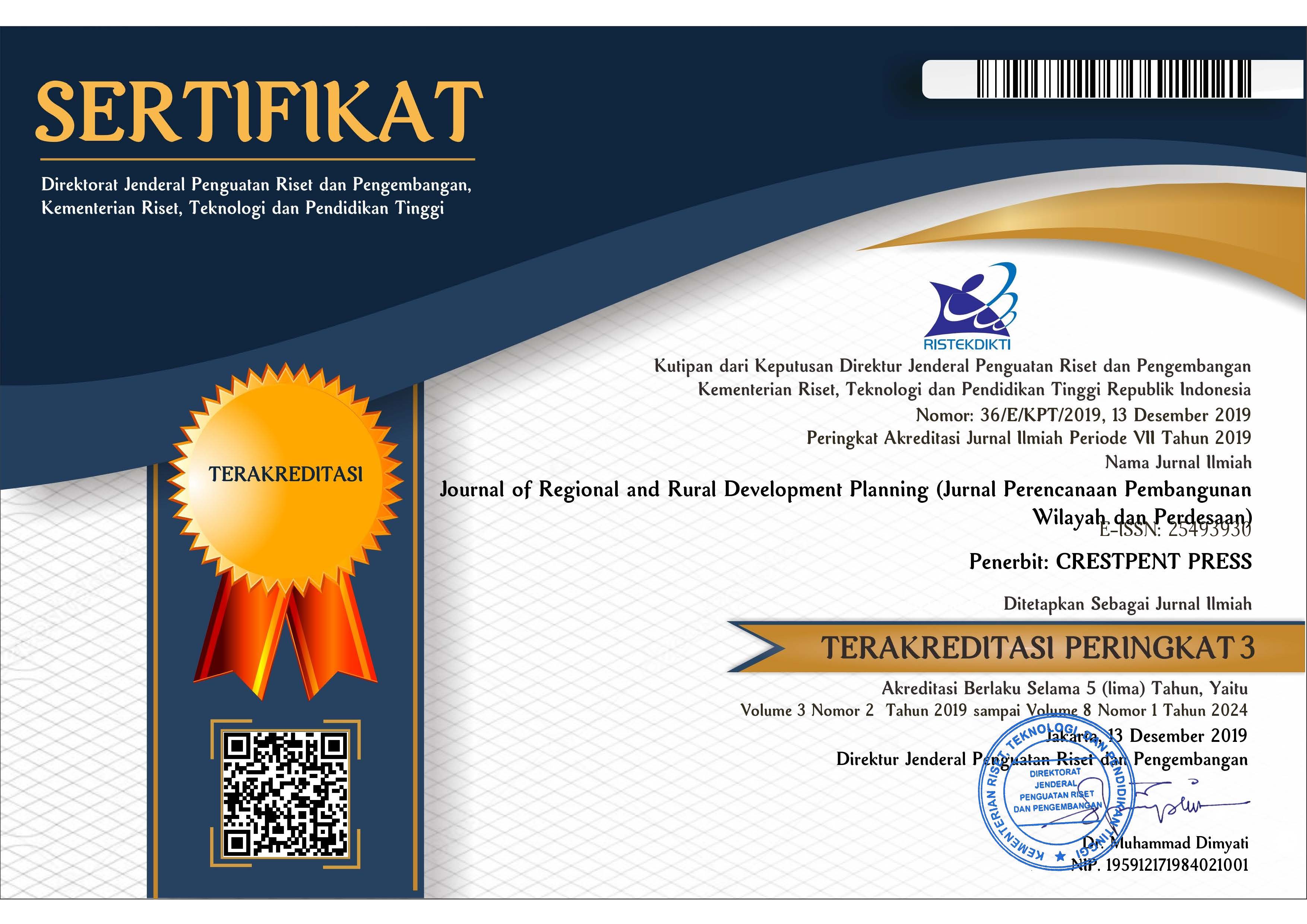Penentuan Pusat-pusat Kegiatan Baru sebagai Alternatif untuk Mengurangi Kemacetan Kota Bogor
Abstract
Bogor city is facing very serious congestion problems. Rearrangement of the spatial structure of the urban growth centers could improve the city's transportation system. This study aims to map the density of traffic, analyze the hierarchy of growth centers, analyze the spatial interactions and formulate alternative arrangement of the centers of the new activities. The study was conducted through descriptive analysis, Schallogram method, the Spatial Gravitation Model and TOPSIS. Schallogram analysis is used to analyze the hierarchy level of service. The Gravity Model is used to analyze the interaction between the regions. TOPSIS analysis is used to identify priority areas and new growth centers. This study analyzed data on the volume of vehicles, facilities area, population, road length, road network maps, and spatial plan (RTRW). The areas in the city center had the highest traffic density and the highest hierarchical. While suburban areas tend to have the lowest hierarchy. Based on the results of gravity model analysis, the areas with the highest attraction located in the city center and extends along the corridor to the north and the south. While the production area spread around the suburbs. Based on the analysis TOPSIS recommend new growth centers, namely Margajaya, Cimahpar, and Bojongkerta.References
Bau, Q. D., Hartono, Parikesit, D., & Gunawan T. (2013). Pengembangan Metode Bangkitan dan Tarikan Perjalanan Berdasarkan Citra Quickbird. Jurnal Transportasi, 13(2), 105-114.
Direktorat Bina Jalan Kota, Direktorat Jenderal Bina Marga, Kementrian Pekerjaan Umum. (1997). Manual Kapasitas Jalan Indonesia.
Fitriana, A.N., Harliana, & Handaru. (2015). Sistem Pendukung Keputusan untuk Menentukan Prestasi Akademik Siswa dengan Metode TOPSIS. CITEC Journal, 2(2), 153-164.
Gulo, Y. (2015). Identifikasi Pusat-Pusat Pertumbuhan Wilayah Pendukungnya dalam Pengembangan Wilayah Kabupaten Nias. Jurnal Widyariset, 18(1), 37-48.
Jati, V. I. M., & Christanto, J. (2012). Kajian Perkembangan Permukiman Wilayah Peri Urban di Sebagian Wilayah Kabupaten Sukoharjo Tahun 2001-2007. Jurnal Bumi Indonesia, 1(1), 1-8.
Kumalasari, D., Soemarno, & Wicaksono, A. (2011). Pengaruh Guna Lahan terhadap Tarikan Pergerakan, Biaya Kemacetan dan Biaya Kecelakaan (Di Jalan KH. Abdul Fatah-Jalan Kapten Kasihin Tulungagung). Rekayasa Sipil, 5(3), 168-179.
Panuju, D. R. & Rustiadi, E. (2012). Teknik Analisis Perencanaan Pengembangan Wilayah. Bogor: Bagian Perencanaan Pengembangan Wilayah, Departemen Ilmu Tanah dan Sumberdaya Lahan, Institut Pertanian Bogor.
Rachmawati, R. & Kurniawan, A. (2006). Pola Pergerakan Keruangan Penduduk Pinggiran Kota dan Pngaruhnya terhadap Konsentrasi Kegiatan di Kota Yogyakarta. Majalah Geografi Indonesia, 20(1), 20-31.
Rui, Y., Ban, Y.,Wang, J., & Haas, J. (2013). Exploring the patterns and evolution of self organized urban street networks through modeling. The European Physical Journal B 86, 74.
Sekretariat Daerah Kota Bogor. (2011). Peraturan Daerah Kota Bogor No.8 Tahun 2011 tentang Rencana Tata Ruang Wilayah Kota Bogor.
Sudarya, D., Sitorus, S. R. P., & Firdaus, M. (2013). Analisis Perkembangan Ekonomi Wilayah untuk Arahan Pembangunan Kecamatan di Wilayah Pesisir Kabupaten Garut. Jurnal Ilmiah Geomatika, 19(2), 134-140.
Tamim, 0. Z. (2000). Perencanaan dan Pemodelan Transportasi. Cetakan Kedua. Bandung: Penerbit ITB
Copyright (c) 2018 Journal of Regional and Rural Development Planning

This work is licensed under a Creative Commons Attribution-ShareAlike 4.0 International License.




.png)














